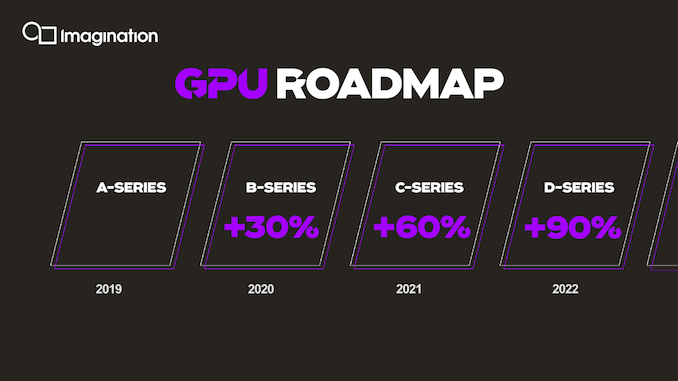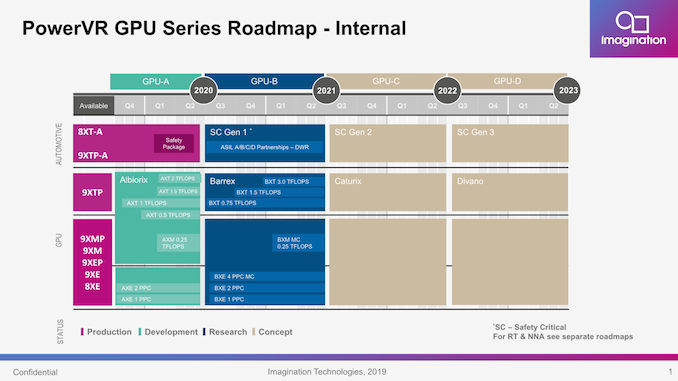Imagination Announces A-Series GPU Architecture: "Most Important Launch in 15 Years"
by Andrei Frumusanu on December 2, 2019 8:00 PM ESTFuture Roadmap & Final Thoughts
The new A-Series architecture means to represent a reset for Imagination’s product offerings, representing a bright new future for the company. The new GPU IP is certainly impressive in terms of the PPA metrics that it promises to achieve, and if realized, it does have ramifications for the wider industry and the competitive landscape.
But even if the A-series can deliver on all of Imagination's promises, the company can't stop there. The competition is continuing to refine and improve their designs, and so must Imagination. To that end, along with today's announcement of the A-series, Imagination is also publishing a very broad roadmap for the next few years, outlining the upcoming GPU generations and their expected performance gains. All of this is especially important for SoC designers, who want to know what's coming down the pipe before making the effort to switch IP vendors.
Imagination’s roadmap following the A-Series is seemingly very aggressive, promising yearly updates going forward, with large annual performance increases of 1.3x, or a 30% yearly compound annual growth rate. This is a much bigger goal than we’re used to historically, but it’s very much in line with the pace of progress we’ve seen from some vendors in the past, or even what Apple has managed to recently achieve over the last two generations.
For the A-Series, Imagination has adopted a public announcement schedule more similar to Arm’s, meaning that the A-Series has already been finished and licensed out to customers, with SoCs being designed and prepared to hit the market for 2020 – we’re assuming the latter part of 2020.
The B-Series is already well under way in terms of development and projected to be completed by next summer if the roadmap is to be taken as an accurate schedule, so at least Imagination has a strong path forward.
What’s important here for Imagination, is managing to actually achieve design wins for the new GPU IP in meaningful higher volume sockets. In terms of possible customers, it’s an increasingly small list, with most of them being the smaller Chinese SoC vendors such as RockChip, Unisoc (formerly Spreadtrum). Samsung is an unlikely client given their plans with AMD as well as custom GPU development, unless there happens to be some opportunity in the low and mid-range segments. HiSilicon likely is tied to Arm, if their plans of a custom GPU don’t pan out. This leaves MediaTek as one of the bigger clients, with the most opportunity and likelihood of adopting the A-Series. Holding onto more MediaTek SoC wins, instead of having them flip-flop between PowerVR and Mali, would be a big win for Imagination and its GPU group. With MediaTek now having re-entered the flagship SoC market, it seems like a very good match.
The wider semiconductor industry is said to be in an architecture revival phase, realizing the need for stronger designs in order to make up for decreasing yearly improvements in process performance. Imagination’s A-Series here seems to be a perfect example of such a revitalization, bringing with it massively impressive generational jumps. If the improvements pan out in practice, I do believe it could be a turning point for the company, and in the future we indeed might look back on it as being the most important launch in the company’s mobile history.












143 Comments
View All Comments
extide - Monday, December 2, 2019 - link
Not exactly an announcement I was expecting to see, but quite interesting. A bit ballsy, but that's pretty much what they need right now. We'll see how it shapes up in actual products...Kishoreshack - Monday, December 2, 2019 - link
This if's & but's in the industry is soo irritatingif it releases on time it will compete well
according to its release schedule we might be at the ending cycle of Mali G77 & introduction of G78
So the performance gains are almost negligible
Pessimist9 - Wednesday, December 4, 2019 - link
But they said it! Quick! Everyone to their brokers STAT!Kishoreshack - Monday, December 2, 2019 - link
Companies overpromising & under delivering is normCOUGH *INTEL*
Seriously until the GPU hits the market
I'm seriously not interested in speculation
I'm over speculation need result's to even be excited about this
Until it is implemented in real world
the idea remains a big cloud of doubt
Cause many companies fail to stick to their release schedule
eek2121 - Tuesday, December 3, 2019 - link
Intel has real GPU products currently, they are just integrated with Intel CPUs. I definitely wouldn't say Intel is 'behind schedule' with Xe either. If you read between the lines, they are shipping 7nm products in 2021, and one of these products is a high performance GPU. As a matter of fact, despite what Intel would have you believe, I suspect that they'll keep their 10nm launches to a minimum and jump straight to 7nm. It also would not surprise me if there is a shake-up in Intel's future that causes their fab business to get spun off into it's own entity to ensure that stuff like this doesn't happen again. That last part is pure speculation though.I'd be rather curious to see how an Intel/AMD/Nvidia GPU stacks up against the Imagination one.
Also note that apparently they aren't shipping open source drivers, which right away is going to create issues for them. NVIDIA is one of the few companies that chose this route, and thus far it's caused nothing but problems for both NVIDIA and the community at large.
Korguz - Tuesday, December 3, 2019 - link
" they are shipping 7nm products in 2021, " yea right,, ill believe that, when it actually happens.." causes their fab business to get spun off into it's own entity" i doubt that would happen. 10nm is VERY late, because they tried to do to much at once, or there is another reason, who knows.. but to spin it off??? not likely
regsEx - Tuesday, December 3, 2019 - link
10 nm is DUV process of highest ever density. It's denser than TSMC 7FF DUV. 7 nm, which is generation of TSMC N3, is EUV. It's easier.TheinsanegamerN - Tuesday, December 3, 2019 - link
That's why they are now 4 years behind schedule, right?mode_13h - Wednesday, December 4, 2019 - link
Exactly.I wonder which hurt Intel more: their over-ambitious process engineers or their greedy management. Either way, while they were sputtering and cavitating, the competition blew right by them.
Their once-unassailable lead was outmatched by their own hubris.
Santoval - Tuesday, December 3, 2019 - link
Intel's 7nm node is apparently going to be slightly denser than TSMC's 5nm node (N5), *not* their 3nm node (N3). I have read about numbers in the range of ~185 million transistors (MTr) per mm^2 for TSMC's N5 and ~200 MTr/mm^2 for Intel's 7nm node. TSMC's N3, in turn, will be 255+ MTr/mm^2. Beside a quite higher density TSMC will switch to GAA-FETs at 3nm, so there can be no direct comparison anyway. In any case Intel will need to deliver 7nm first, and I strongly doubt they will manage to completely master EUV manufacturing of multiple layers by 2021.By the way, Intel's 10nm is not denser than TSMC's N7 DUV. Intel has developed three 10nm variants, for low, mid and high density. Only the high density (and highest performance) 10nm variant is slightly denser than TSMC's N7 DUV and even that was already outclassed in density by TSMC's N7 EUV (7nm+).
To my knowledge Intel employs the mid density 10nm variant for the mobile Ice Lake parts they just released, so they haven't released and aren't about to release any 10nm SoC, CPU or GPU that is denser than even TSMC's vanilla (DUV) N7. Their sole high density (100+ MTr/mm^2) 10nm parts are probably their newest Agilex FPGAs.